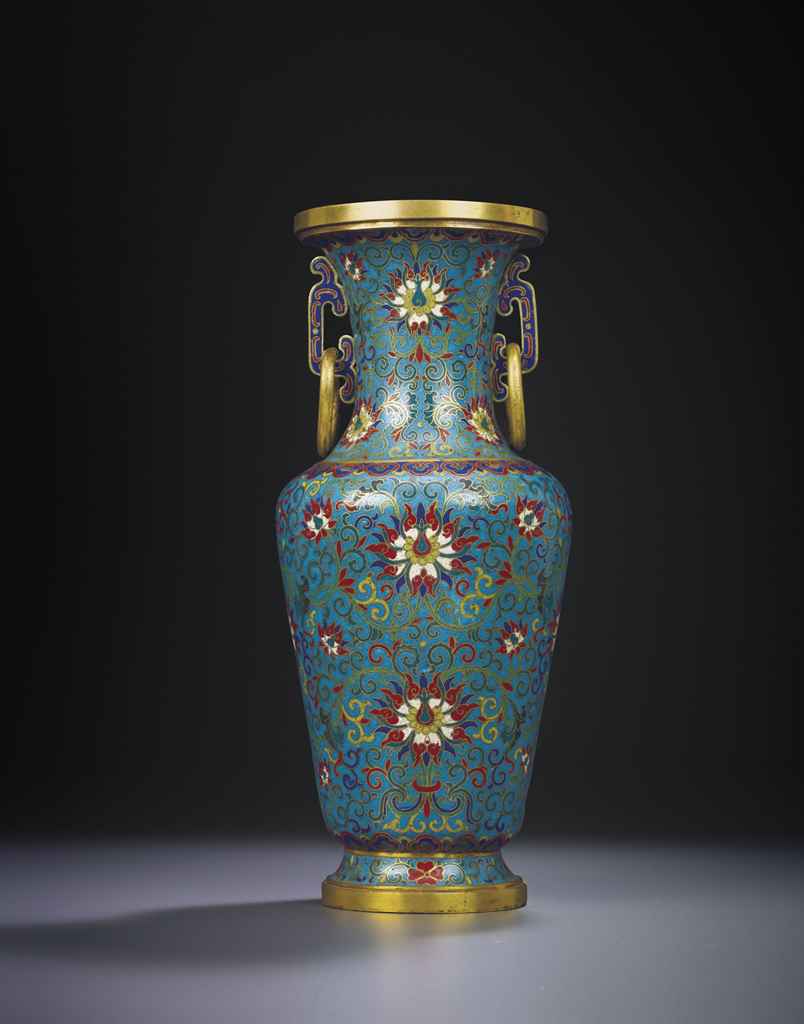The Property of a Gentleman 紳士藏品 An imperial cloisonné and champlevé enamel 'phoenix' ice chest Qianlong/Jiaqing Of square section with straight sides tapering to the base, divided into three horizontal registers by two raised ribs, the middle section enamelled with shou medallions within a foliate sunburst, flanked by a pair of formal lotus flowers, the top and bottom registers each with pairs of confronted red phoenixes centred on a blue bat grasping a wan character in its mouth, all reserved on a dense foliate turquoise-blue ground, two sides set with gilt-bronze C-shaped handles, the interior with a fitted metal liner, wood stand. 34 x 68 x 68 cm (13 3/8 x 26 7/8 x 26 7/8 in) (2). Fußnoten 清乾隆/嘉慶 禦制銅胎掐絲及內填琺瑯福壽瑞鳳紋冰盒 Provenance: a European private collection, acquired from Anna Puchar del Bello in 1968, who inherited it from her father, a captain on a Trieste-based merchant ship that often travelled to the Asia. 來源:歐洲私人收藏,現藏家於1968年購自一名往返於意大利里雅斯特與亞洲間商船船長之女,Anna Puchar del Bello Impressive in size and its magnificent detailed design, the decorative combination of auspicious motifs such as phoenixes, bats and shou characters on a dense foliate scroll indicate that it most likely was intended for the emperor's chambers. A related cloisonné enamel ice chest, Qianlong mark and of the period, but decorated with foliate lotus scrolls, is illustrated in The Complete Collection of Treasures of the Palace Museum: Metal-bodied Enamel Ware, Hong Kong, 2002, pl.129. Ice chests were filled with ice and used in the Qing palaces during the hot summer months to cool drinks and food, as well as cooling the surrounding area. In winter ice blocks were cut from the Inner Golden River and were stored in the five ice vaults in the Forbidden City near the Gate of the Great Ancestors. During the period from the first day of the fifth month to the twentieth day of the seventh month specific members of the imperial Household Department received an allocation of two blocks of ice per day. The pierced covers of the ice box allowed cool air to escape, which would then be fanned into the rooms by servants. Large ice chests of this type derive from wooden prototypes lined with a metal such as lead; see an example in the Victoria and Albert Museum, London, illustrated by C.Clunas, Chinese Furniture, London, 1997, p.99, pl.89. The form and horizontal gilt-metal ribs are examples of the original wooden structure that have been retained, along with the transportable nature of these chests represented by in the sturdily-constructed handles. Compare with a related cloisonné enamel ice chest, Qianlong, which was sold at Christie's New York, 20 0ctober 2004, lot 601.
The Property of a Gentleman 紳士藏品 An imperial cloisonné and champlevé enamel 'phoenix' ice chest Qianlong/Jiaqing Of square section with straight sides tapering to the base, divided into three horizontal registers by two raised ribs, the middle section enamelled with shou medallions within a foliate sunburst, flanked by a pair of formal lotus flowers, the top and bottom registers each with pairs of confronted red phoenixes centred on a blue bat grasping a wan character in its mouth, all reserved on a dense foliate turquoise-blue ground, two sides set with gilt-bronze C-shaped handles, the interior with a fitted metal liner, wood stand. 34 x 68 x 68 cm (13 3/8 x 26 7/8 x 26 7/8 in) (2). Fußnoten 清乾隆/嘉慶 禦制銅胎掐絲及內填琺瑯福壽瑞鳳紋冰盒 Provenance: a European private collection, acquired from Anna Puchar del Bello in 1968, who inherited it from her father, a captain on a Trieste-based merchant ship that often travelled to the Asia. 來源:歐洲私人收藏,現藏家於1968年購自一名往返於意大利里雅斯特與亞洲間商船船長之女,Anna Puchar del Bello Impressive in size and its magnificent detailed design, the decorative combination of auspicious motifs such as phoenixes, bats and shou characters on a dense foliate scroll indicate that it most likely was intended for the emperor's chambers. A related cloisonné enamel ice chest, Qianlong mark and of the period, but decorated with foliate lotus scrolls, is illustrated in The Complete Collection of Treasures of the Palace Museum: Metal-bodied Enamel Ware, Hong Kong, 2002, pl.129. Ice chests were filled with ice and used in the Qing palaces during the hot summer months to cool drinks and food, as well as cooling the surrounding area. In winter ice blocks were cut from the Inner Golden River and were stored in the five ice vaults in the Forbidden City near the Gate of the Great Ancestors. During the period from the first day of the fifth month to the twentieth day of the seventh month specific members of the imperial Household Department received an allocation of two blocks of ice per day. The pierced covers of the ice box allowed cool air to escape, which would then be fanned into the rooms by servants. Large ice chests of this type derive from wooden prototypes lined with a metal such as lead; see an example in the Victoria and Albert Museum, London, illustrated by C.Clunas, Chinese Furniture, London, 1997, p.99, pl.89. The form and horizontal gilt-metal ribs are examples of the original wooden structure that have been retained, along with the transportable nature of these chests represented by in the sturdily-constructed handles. Compare with a related cloisonné enamel ice chest, Qianlong, which was sold at Christie's New York, 20 0ctober 2004, lot 601.

.jpg)







.jpg)
.jpg)

.jpg)


Testen Sie LotSearch und seine Premium-Features 7 Tage - ohne Kosten!
Lassen Sie sich automatisch über neue Objekte in kommenden Auktionen benachrichtigen.
Suchauftrag anlegen